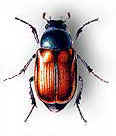GARDEN
CHAFER
Phyllopertha horticola |

Morphology
The adult Garden chafer has
a length of about 9 millimeter. Head and mesothorax are dark metal green to black. Elytra
are reddish brown with a metal gloss.
Distribution
If all identifications are correct, the Garden chafer has a Eurasian distribution. In The
Netherlands it is the most common species and it appears on sandy soils which have a
predominantly dry character. Their presence is reported from the provinces of Drenthe,
Overijssel, Gelderland, Noordholland (dune-district), Utrecht, Brabant en Limburg.
The chafers prefer warm and dry sandy soils which are pervious to water in heavy rain.
Generally pastures in the Netherlands are well treated with slurry consisting of high
organic matter and therefore with water retaining ability. This might be the reason that
the Garden chafer does not play a role in the typical pasture areas. As an exception some
problems with the species arose in a pasture which was used exclusively for mowing. This
very dry pasture had a proper perviousity for water without a thick layer of organic
matter.
Well drained sportsfields run a high risk of grub attack, as well as turfgrass on slopes.
The fact that the middle parts of sportsfields, e.g. sockerfields, become rarely damaged
may be caused by condensation of the soil.
Biology
The Garden chafer has one generation per year. At the end of May, when adults leave their
pupae it takes some days before they are fully coloured and hardened. They surface and
flight activity starts, depending on the weather. The adults fly between 10.00 and 12.00
a.m., only in sunny weather. The flight period is from the end of May until the second or
third week of June, depending on the weather conditions.
The biology of the females has two phases. In phase one females crawl up through the soil
and surface. At this moment males are present in high numbers and mate as soon as a female
surfaces. After mating the female digs in the soil and starts laying eggs.
Eggs are laid in groups of 2-6 eggs at a depth of about
10cm. The number of eggs varies between 10 and 50. After the females have deposited 70% of
the eggs the second phase starts. The females crawl up again. They start a short feeding
period on trees and shrubs, preferably on broad leaved trees. From there they fly away in
a straight line to find another suitable place for egg-laying. The direction of this
flight is at random and can be several kilometers. In the English literature this is known
as "bee-liners". This behaviour could be an explanation for the local
distribution in the field. The ecological impact of phase one is to maintain the local
population and phase two is responsible for spreading of the population and gene-flow.
Eggs have a developing time of four weeks which means that the first larvae can be
expected in the beginning of July. The small grubs start feeding at hair roots. The second and third instar
feed on the thicker roots of the grass.
After completion the third instar empties its gut contents
and digs deeper in the soil in order to hibernate. This grub is recognizable for its
creamy white color. The first diapauze larvae can be found in the second week of October,
the last ones in the middle of November. Pupae are found at the end of April.
Copyright © Insect
Consultancy 2002

